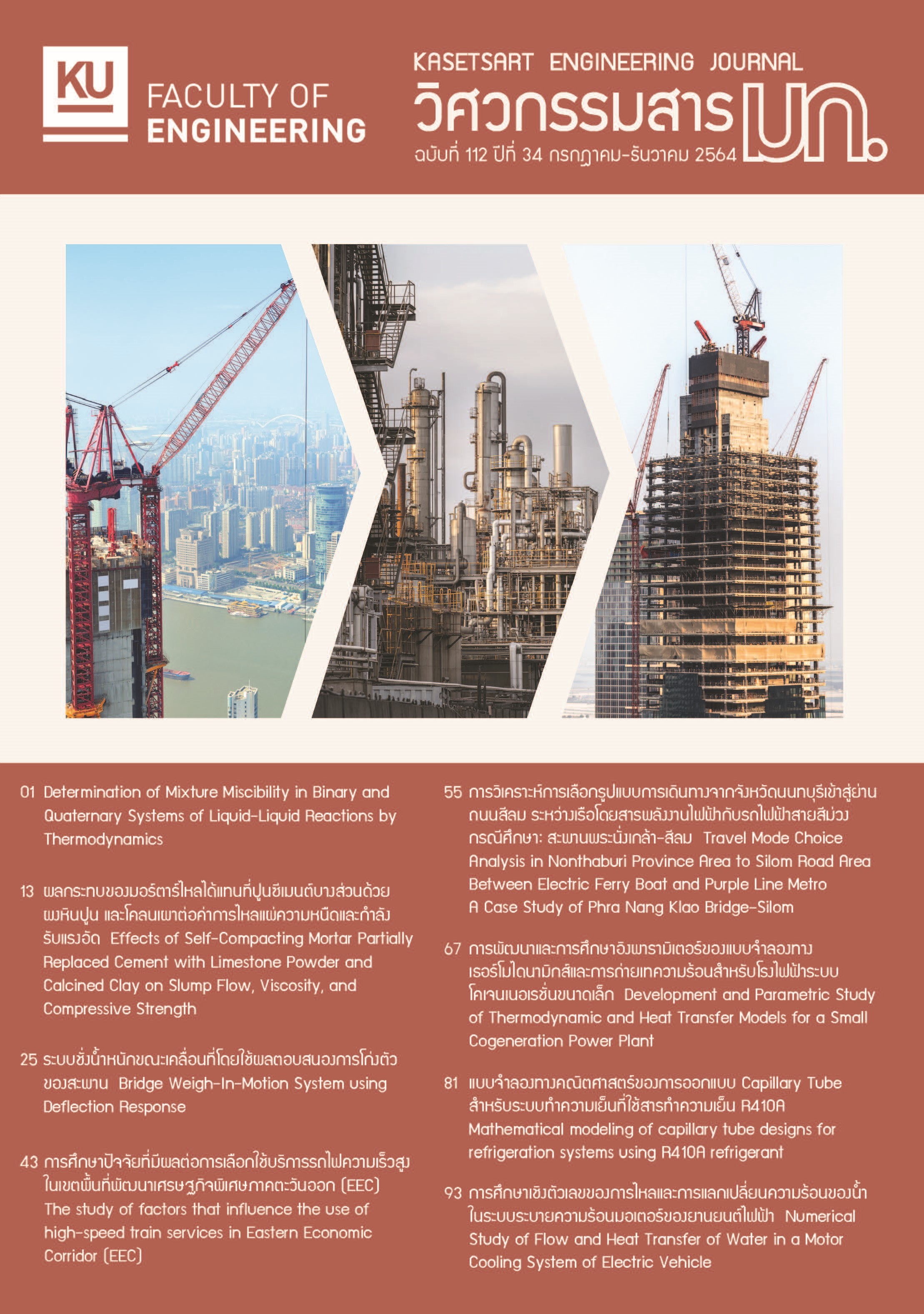Development and Parametric Study of Thermodynamic and Heat Transfer Models for a Small Cogeneration Power Plant
Keywords:
Parametric study, Cogeneration efficiency, Primary Energy SavingAbstract
Cogeneration is high efficiency technology and consists of gas turbine, steam turbine and heat recovery steam generator. In the present research study, optimization model of a small cogeneration power plant in Thailand is developed, and the realistic cogeneration model is analyzed and improved by thermodynamic and heat transfer models. The numerical solution is obtained by using MATLAB. Furthermore, the important parameters that affect energy consumption and efficiency are the heat rate of fuel and the valve controlling high pressure at steam turbine outlet. The result from the simulation indicates that for the baseline case the cogeneration efficiency is 56.96% and the Primary Energy Saving (PES) is 16.72%. For the parametric study, by increasing the heat rate of fuel by 3%, the cogeneration efficiency and Primary Energy Saving increase to 57.50% and 17.53%, respectively. On the other hand, by increasing the high pressure at the steam turbine outlet by 7.5 bar, the cogeneration efficiency is nearly a constant and the Primary Energy Saving decreases to 16.62%.
References
การไฟฟ้าฝ่ายผลิตแห่งประเทศไทย (2564). กราฟและสถิติ. เข้าถึงได้จาก https://www.egat.co.th/index. php?option=com_content&view=article&id=76&Itemid=116 01 กันยายน 2564.
บริษัท ปตท. จำกัด (มหาชน) (2549). ระบบโคเจนเนอเรชั่น. วารสารธุรกิจสีเขียว, 4, ตุลาคม-ธันวาคม.
คณะกรรมการกำกับกิจการพลังงาน (2560). คู่มือการตรวจวัดประสิทธิภาพของระบบผลิตพลังงานไฟฟ้าและความร้อนร่วมและการคำนวณค่า PES สำหรับผู้ผลิตไฟฟ้ารายเล็ก (ระบบ Cogeneration).
Sanjay (2011). Investigation of effect of variation of cycle parameters on thermodynamic performance of gas-steam combined cycle. Energy, 36(1): 157-167.
Ahmadi P, and Dincer I. (2011). Thermodynamic analysis and thermoeconomic optimization of a dual pressure combined cycle power plant with a supplementary firing unit. Energy Conversion and Management, 52(5): 2296-2308.
Mehrgoo M, and Amidpour M (2017). Constructal design and optimization of a dual pressure heat recovery steam generator. Energy, 124: 87-99.
Kaviri A G, Jaafar M N M, Lazim T M, and Barzegaravval H (2013). Exergoenvironmental optimization of Heat Recovery Steam Generators in combined cycle power plant through energy and exergy analysis. Energy Conversion and Management, 67: 27-33.
Woudstra N, Woudstra T, Pirone A, and Stelt T v d (2010). Thermodynamic evaluation of combined cycle plants. Energy Conversion and Management, 51(5): 1099-1110.
Srinivas T, Gupta A V S S K S, and Reddy B V (2008). Sensitivity analysis of STIG based combined cycle with dual pressure HRSG. International Journal of Thermal Sciences, 47(9): 1226-1234.
Ganjehkaviri A, Mohd Jaafar M N, and Hosseini S E (2015). Optimization and the effect of steam turbine outlet quality on the output power of a combined cycle power plant. Energy Conversion and Management, 89: 231-243.
Buntarikpornpant P, and Tangthieng C (2020). A Parametric Investigation of the Steam Injection Gas Turbine System on a Cogeneration Plant. Engineering Journal, 24(1): 11-21.
Dincer I, and Rosen M A (2021). Chapter 13 Exergy analyses of cogeneration and district energy systems. In I. Dincer & M. A. Rosen (Eds.), Exergy (Third Edition): 355-381.
Borgnakke C, and Sonntag R E (2020). Fundamentals of thermodynamics. John Wiley & Sons.
Bergman T L, Lavine A S, Incropera F P, and DeWitt D P (2011). Introduction to heat transfer. John Wiley & Sons.
Downloads
Published
Issue
Section
License

This work is licensed under a Creative Commons Attribution-NonCommercial-NoDerivatives 4.0 International License.


